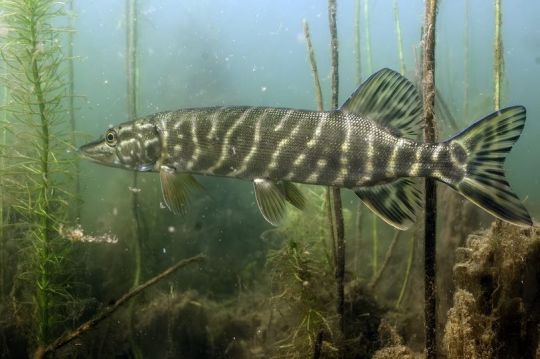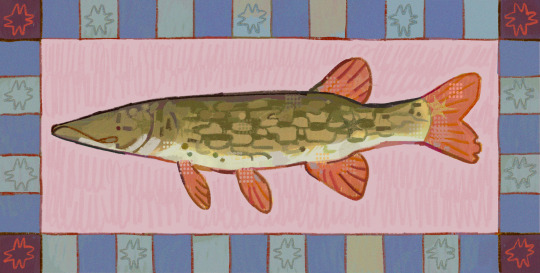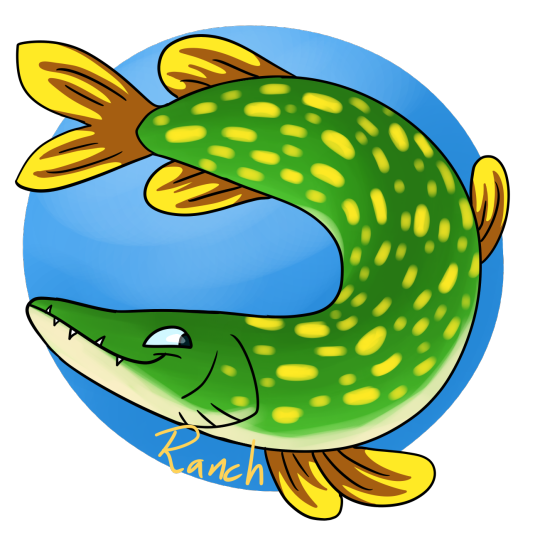#esoxs
Explore tagged Tumblr posts
Text

Northern Pike (Esox lucius), family Esocidae, Hampshire Chalk Pit, England, UK
photograph by David Miller
355 notes
·
View notes
Text

Pike Courtship, Northern pike (Esox lucius), Stoney Cove, Leicestershire, England
‘This photo was taken on a dive aimed at finding breeding pike in a quarry. I came across a group of six pikes, two of which moved off, leaving this group of four – three males and a female (furthest from view). During courtship, the males are oblivious of divers, so it was possible to get close to them and take a series of pictures’
Photograph: Robert Cuss
British Wildlife Photography Awards
#robert cuss#photographer#british wildlife photography awards#northern pike#fish#esox lucius#stoney cove#leicestershire#england#underwater#nature
37 notes
·
View notes
Text

A gift for a friend back home who's recently getting into esox
2 notes
·
View notes
Text

Esox lucius caught out of a small creek in NW Ohio in mid June.
7 notes
·
View notes
Text
The river current is kinda strong today guys I don’t know if I can stay up here
3 notes
·
View notes
Text
Northern pike
I sometimes get asked, about keeping pike in an aquarium. The only species of true pike, I have experience with, is the northern pike of Eurasia, Esox lucius. This is a huge predator, growing to around 150 centimeters or 5 feet long, and realistically requires a pond environment, when it reaches full size. And it would need to be a large pond at that, at least four times the length of the pike, by two and a half times its length.
Northern pike inhabit vegetated lakes, slow moving creeks, and the backwaters of rivers. Their primary prey is fish, but amphibians and freshwater lobsters are also important food animals, depending on locality. Other animals on their menu, include swimming birds, water snakes, and small mammals. That said, aggression by pike is purely for food, and non-prey are not harassed by these otherwise gentle giants.
Larger pike do eat smaller pike, so care should be taken when cohabiting them together. As pikes can take prey up to even 1/2 their own length, suitable tankmates must be selected with care. However, the jaws of pike do not have an exceptional vertical gape, meaning large, deep bodied fishes over a 1/3 of a pikes total length, are not seen as prey.
Data from wild E. lucius, indicate they have a wide pH tolerance, ranging from 5 to 9. However the fish flourishes best at a close to neutral pH. The temperture for happy, healthy pike should be at least 10 degrees centigrade, and never allowed to rise, as high as 20 degrees. Their tank or pond should be well vegetated, with a talk, grassy plant such as Valisneria, or artificial plants.
Although pike can obviously withstand much cooler temperatures in the wild, this is purely seasonal, and such temperatures are unsuitable, for year round care. These are a true coldwater fish, and do not appreciate warm waters. On the other hand the adaptability of pike to water parameters is such, that some pike populations are found in brackish waters, with a specific gravity up to 1.008. It appears that pike must be exposed to these conditions as fry, to be tolerant of them as adult fish.
Feeding E. lucius on aquarium fare can be tricky. Many will only consume live fishes, but on fish farms, they are raised to consume protein-rich pellets. Therefore the notion that pike must be fed live fishes, is patently untrue. These fish do not need to eat often, because their lurking demeanor evolved to save energy. However, the tank filtration will need to be powerful, because of the volume of waste E. lucius are able to produce.
0 notes
Photo

🎣 Coarse Fishing season is upon us 🎣 Stay with us & fish for free …..🐟 #fishingscotland #fishing #catchandrelease #troutfishing #flyfishing #lurefishing #rainbowtrout #esox #scotland #pikefishing #visitscotland #hecht #perchfishing #flytying #flytyingjunkie #rainbowtroutflyfishing #muskyfishing #browntroutflyfishing #snoek #fishinguk #boatfishing #troutflyfishing #fishingphotography #g #fish #flyfishingscotland #musky #flytyingphotography #flyfishingjunkie #pike https://www.instagram.com/p/CpvnNCnj506/?igshid=NGJjMDIxMWI=
#fishingscotland#fishing#catchandrelease#troutfishing#flyfishing#lurefishing#rainbowtrout#esox#scotland#pikefishing#visitscotland#hecht#perchfishing#flytying#flytyingjunkie#rainbowtroutflyfishing#muskyfishing#browntroutflyfishing#snoek#fishinguk#boatfishing#troutflyfishing#fishingphotography#g#fish#flyfishingscotland#musky#flytyingphotography#flyfishingjunkie#pike
0 notes
Text
Hurrah! Thank you for the tag :D
My Type by Saint Motel
Hauki by Ultra Bra
Zero to Hero from the Hercules soundtrack
Anyone can join :) I don't really know whom to tag haha
MUSIC LOVERS ASSEMBLE!!
i feel like starting a tag chain so i hope this works out :)
reblog this with 3 songs:
the song your listening to right now (or last one you listened to)
your current favourite song
a song of your choice
______________________________________________________________
mine:
its now or never - elvis presley/love in the dark - adele
trastevere - måneskin
nevermore - queen
______________________________________________________________
tagggzzzz: (np ofc) @heartstopper-lover123 @s0lit4ir3 @ali-da-demon @vicwritesfic @skeelly @charliethinks @tori-my-love @chronic-skeptic @toulouseradiosilence @stewpid-soup @nine-frogs-in-a-trenchcoat @pessimistic-gh0st @theshyqueergirl @crowleybrekkers @a-bowl-of-soop @frogfairy444 @robinheaney12 @fairyghostgirlgaming @thatsawesomedontyouthink @venusplanetoflove2 @thelovelyvie @abookishshade @spir4nts-lun4r @i-have-no-idea-111 @kit-the-queer @a-wondering-thought @scatteredraysofhope @coco6420 @softlyunbreakable @givennnnnn @far-beyond-saving @darling-im-wonderstruck @heartstoppernerdsstuff @nonbinary-idiot-obviously @rebelrobinrules1984 @daydream-of-a-wallflower @leonine-elizer @angel-devil-star and anyone else who wants to join!!
#my sister and i have been listening to a lot of disney soundtrack songs lately#the automatically generated playlists always put in zero to hero without fail but im not complaining. that song slaps#also i must request that everyone listens to hauki by ultra bra. it is the best song in the world#no other song about the pike (Esox lucius) has a brass part does it?#not fish#long post
6K notes
·
View notes
Text

fishtober day 05:
redfin pikerel (esox americanus americanus)
#inktober#fishtober#freshwater fish#redfin pikerel#queer#trans#digital art#my art#ohew almost didnt make it today
2K notes
·
View notes
Text
Wet Beast Wednesday: northern pike
It's time for more fun in fresh water with one of the northern hemisphere's primary predatory fish. The northern pike is the tiger of the lakes: a powerful ambush predator that is at the top of the food chain. Popular amongst naturalists and anglers alike, the northern pike is a fairly famous fish. Let's dive in.

(Image: a northern pike seen form the side. It is a long, torpedo-shaped fish with a long head and large jaws. The dorsal and anal fins are very far back on its body. Its body is an olive green with white spots. End ID)
Esox lucius is a large, tube-shaped fish that reaches an average of 40-55 cm (16-22 in) long but can reach a maximum recorded size of 150 cm (59 in) and 28.4 kg (63 lbs). The head is elongated with long, sharp teeth and the most of the fins are far back on the body. The fin placement and body shape allows the pike rapid bursts of speed. The body is an olive green with white spots and a white or yellow underbelly. The head is covered with sensory pores that are an extension of the lateral line and therefore aid in sensing movement. The skin has a thick coating of protective mucus and is easily damaged. The northern pike is similar to the Amur pike (Esox reichertii), Aquitanian pike (Esox aquitanicus), and southern pike (Esox cisalpinus), all of which were previously though to be of the same species as the northern. The northern pike is also similar to the muskellunge (Esox masquinongy) and the two are capable of interbreeding to produce a hybrid called a tiger muskie.

(Image: a northern pike seen from below and the front, showing off its white underbelly. End ID)

(Image: a tiger muskie being held by a fisherman. Its body shape is similar to a northern pike's, but is more silvery with long, greenish stripes. End ID)
Northern pike are found throughout Europe and north Asia, as well as eastern North America. They are found in slow-moving streams and lakes and prefer places with lots of plant cover, which often restricts them to locations nearer the shore. The vegetation is needed both for their hunting strategy and reproduction. During winter and cloudy days and nights, they venture further from the vegetation. Pike are ambush predators that wait motionless in vegetation for prey to pass before attacking with a sudden burst of speed. Pike will pursue prey, but are not as good at long-distance pursuit at many other species of predatory fish. They are known as aggressive fish with a very broad diet including fish, frogs, small mammals, invertebrates, and aquatic birds. There have also been reports of pike attacking dogs and humans, likely while mistaking extremities for small fish. Pike are also aggressive toward each other. They are territorial and will compete for the best hunting grounds. Pike are also cannibalistic and will eat smaller members of their species. Young pike need vegetation as cover to hide from larger pike. Pike are generally solitary animals, though there are reports of pike engaging is what is apparently group hunting. They are somewhat migratory as they will follow migratory prey to their winter habitats.

(Image: a northern pike eating a frog. End ID)
Pike mate during spring, beginning when water temperature reaches 9 C (48 F). They have strong homing behavior, returning to the same breeding grounds where they hatched. Males arrive to the breeding grounds before females do and leave afterwards. Females release thousands of orange, sticky eggs for he males to fertilize. The eggs sink and stick to rocks and plants. Stable conditions above 6 C without high iron concentrations are best for egg development. The young hatch in an embryonic stage that lasts for 5-16 days depending on temperature before transitioning to larvae. The larvae feed on planktonic invertebrates until they reach between 4 and 8 cm, when they switch to feeding on small fish. The mortality rate of larvae is around 95%. Northern pike reach sexual maturity around 2 years and can live up to 25 years, with an average of 10-15 years.

(Image: a juvenile northern pike. It looks like a smaller version of an adult. End ID)
Northern pike are classified as least concern by the IUCN. They are prized by anglers for their size and the fight they put up when hooked. Even when released, their skin can easily be damage by handling, leading to increased mortality. Releasing them when still in the water is recommended. Like many species of sport fish, their average sizes have decreased as a result of overfishing. Because of their popularity as sport fish, northern pike are often stocked in lakes. In eastern North America they have been introduced to lakes outside their native range, leading to them damaging native fish populations. In southern Alaska and Washington they are considered invasive species. Northern pike are edible, though they are bony and need special skill to fillet.

Linking (Video: a pike chasing a lure from the POV of a camera attached to the lure. End ID)
#wet beast wednesday#northern pike#pike#fish#fishblr#fishposting#freshwater fish#freshwater ecology#biology#ecology#zoology#animal facts#informative#educational#image described
75 notes
·
View notes
Note
may i please request a fish in this trying time?
Of course!

You get an American Pickerel
Esox americanus
62 notes
·
View notes
Text
Fish of the Day
Today's fish of the day is the muskellunge!

The muskellunge, also called a musky, lunge, ski, and scientific name Esox masquinongy, is known for being the largest species of pike. Muskellunge can be found around the rivers of Michigan, specifically the Great Lakes region, Canadian waters, St Lawrence River, and around the Mississippi and Ohio river valleys. Outside of their natural range, they can also be found around the Tennessee river, South Carolina rivers, and as far South as Upper Georgia, where they are kept stocked intentionally for recreational fishing. They live around clean and clear waters with little silt, preferring to surround themselves with aquatic vegetation and weeds. This is because they tend to lurk near weedy shores and rocky outcroppings, although they can be found in deeper waters during the summer.

The diet of the muskie is made up primarily of other fish, although they will also eat: frogs, water birds, rats, and other animals that can be found in and around their environments. On rare occasions, muskellunge have been reported attacking dogs and children They attack other animals in an ambush, where the muskie will swiftly bite and swallow, not allowing any time for prey to fight back or escape. They can get as large as 50 inches in length, but there are claims of fish getting as large as 6ft. They have few predators, only large birds, such as bald eagles, other larger muskellunge or pike, and human fishing. With human fish thought to be the cause of their declining numbers.

Similar to other pikes, the muskellunge form small schools, and will claim territories that they fiercely defend, only becoming more aggressive during the breeding season. They spawn in the spring, like other pike, finding clean rocks or sandy bottomed rivers to lay their eggs. Spawning is only around a week to two weeks in length, and eggs are abandoned almost immediately. Once born, juveniles are only a few cm in length, but can get as large as 12 inches by their first year of life, and can get as old as 12-18 years.

That's the muskie fish, have a good day, everyone!
#fish#fish of the day#fishblr#fishposting#aquatic biology#marine biology#freshwater#freshwater fish#animal facts#animal#animals#fishes#informative#education#aquatic#aquatic life#nature#river#ocean#muskellunge
95 notes
·
View notes
Text
ichthyology classes got me fucked up because now i'm identifying random fish in random places but it's not like. actionable. like now i can immediately recognize my cat's plush fishy toy as being a pike, genus Esox, family Esocidae, but what the hell am i supposed to do with that info
105 notes
·
View notes
Text
They call me crayfish consumer on account of. Well it’s pretty self explanatory.
3 notes
·
View notes
Text
🐟 Fishuary 2024 Day Sixteen: Freshwater Fish 🐟

I had to draw the northern pike (Esox lucius) eventually of course! My second favourite fish :)
@fish-daily
80 notes
·
View notes
